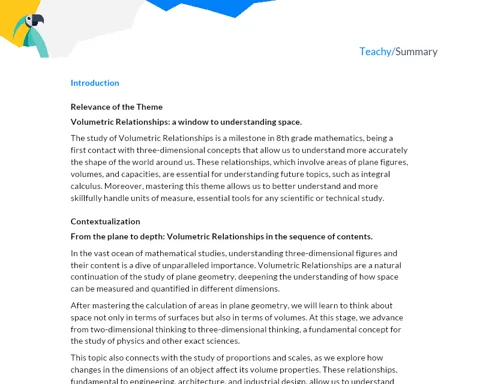Exploring the Properties of Probability: From Theory to Practice
Objectives
1. Recognize and use the property that the sum of all possible events equals 1.
2. Solve practical problems by applying the properties of probability.
Contextualization
Probability is an area of mathematics that studies the chance of events occurring. In our daily lives, we often deal with situations that involve probability, such as predicting the weather, making decisions in games of chance, or even assessing risks in financial investments. Understanding the properties of probability allows for more informed decision-making and more accurate risk assessment. For example, insurance companies use probability theories to calculate the risk of an event occurring and thus determine the value of policies. In the financial market, risk analysts use probability to predict market fluctuations and guide investment decisions. In technology, machine learning algorithms apply probabilistic principles to make predictions and classifications.
Relevance of the Theme
Understanding the properties of probability is essential in today's context, as it allows for data-driven and probability-based decision-making. This is crucial in various professional fields such as finance, insurance, technology, and even in everyday life. The ability to calculate and interpret probabilities can positively influence decision-making, mitigating risks and increasing efficiency and precision in different scenarios.
Concept of Probability
Probability is a measure that quantifies the chance of an event occurring. It is expressed as a number between 0 and 1, where 0 indicates that the event will not occur and 1 indicates that the event will certainly occur. Probability is used to predict the occurrence of events in uncertain situations.
-
Probability is always a value between 0 and 1.
-
It can be expressed as a fraction, decimal, or percentage.
-
Helps in making informed decisions under uncertainty.
Property of the Sum of Possible Events
One of the fundamental properties of probability is that the sum of all probabilities of possible events in a sample space equals 1. This means that the sum of the probabilities of all possible outcomes of an experiment is always 1.
-
The sum of the probabilities of all possible events is always equal to 1.
-
Allows verification of whether the assigned probabilities are correct.
-
Essential for calculating the probability of complementary events.
Independent and Dependent Events
Independent events are those whose occurrence does not affect the occurrence of the other. In contrast, dependent events are those where the occurrence of one event affects the probability of the other event occurring. Understanding this distinction is crucial for correctly calculating compound probabilities.
-
Independent events: The occurrence of one event does not affect the other.
-
Dependent events: The occurrence of one event influences the probability of the other.
-
Important for calculating the joint probability of multiple events.
Practical Applications
- Insurance: Insurance companies use probability to calculate the risk of events like accidents and to determine policy values.
- Financial Market: Risk analysts use probability to predict market fluctuations and guide investment decisions.
- Technology: Machine learning algorithms apply probabilistic principles to make predictions and classifications.
Key Terms
-
Sample Space: The set of all possible outcomes of an experiment.
-
Event: Any subset of the sample space.
-
Conditional Probability: The probability of an event occurring given that another event has already occurred.
-
Complementary Events: Two events that together encompass all possible outcomes of the sample space.
-
Independent Events: Events whose occurrence of one does not affect the occurrence of the other.
Questions
-
How can understanding the properties of probability influence your daily decisions?
-
In what ways is probability used in your area of interest or potential future career?
-
Why is it important to understand the difference between independent and dependent events in problem-solving?
Conclusion
To Reflect
Understanding the properties of probability is essential for making informed decisions in various everyday situations and in the job market. By studying how to calculate the probability of simple and compound events and understanding the importance of the sum of probabilities being equal to 1, we can apply this knowledge in fields such as finance, insurance, and technology. Moreover, recognizing the difference between independent and dependent events helps us solve problems more accurately and effectively. Reflecting on the application of these concepts in your daily life and future careers can enhance your ability to make data and probability-based decisions, mitigating risks and increasing efficiency.
Mini Challenge - Practical Simulation of Random Events
This mini-challenge aims to consolidate the understanding of the properties of probability through the creation and analysis of random events.
- Divide into groups of 4-5 students.
- Choose a set of materials: dice, coins, playing cards, or tokens.
- Each group should create a game situation or random event, such as a dice game or the probability of drawing a specific card from the deck.
- Calculate the probability of the created events using the properties of probability discussed in class.
- Present your calculations and results to the class, explaining the reasoning behind your conclusions.



